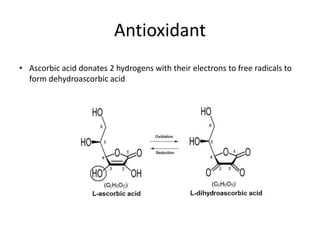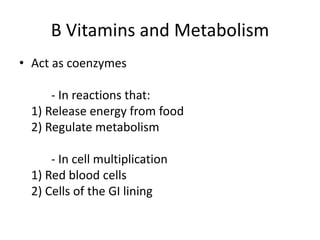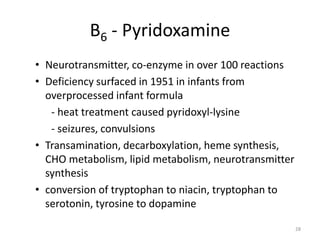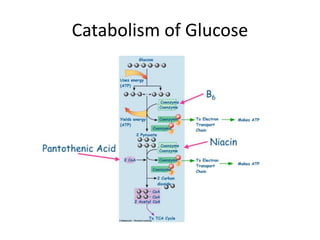Water soluble vitamins
- 1. Vitamins • Are required for proper metabolism • Do NOT directly provide energy • Are necessary for obtaining energy from the macronutrients • Often function as coenzymes
- 2. Vitamin C • Scurvy described as far back as 1500 BC • 1757 Lind found that cider, vinegar, oranges, lemons prevented scurvy
- 3. Antioxidant • Ascorbic acid donates 2 hydrogens with their electrons to free radicals to form dehydroascorbic acid
- 4. Functions • Keeps iron and copper in reduced states • Iron absorption • Enhances immune function (WBC, balance of phagocytosis) • Synthesis of: Collagen (Fe), Carnitine (Fe), Neurotransmitters (Cu), hormones • Conversion of cholesterol to bile acids • Linus Pauling – the common cold?
- 8. Cofactor and coenzymes • Cofactor: a non-protein chemical compound that is bound to a protein and is required for protein’s biological activity. • Cofactors are either organic or inorganic. Cofactors are often classified as inorganic, while coenzymes are often classified as organic.
- 9. Water Soluble B Vitamins
- 10. Foods with B vitamins • In general, B vitamins are found in a wide range of foods • B vitamins are more likely found in foods of animal origins (B12), protein rich foods, whole-grain foods, fortified foods
- 11. Keeping B Vitamins in Foods • Easily destroyed by UV rays (sun), heat, exposure to oxygen – Implications for cooking and storage • Water soluble – They leach out of foods when washed and cooked in water
- 12. B Vitamin Toxicity • Some B vitamins are toxic if too much is consumed: – Niacin: Flush, Liver damage, Impaired glucose regulation – B6: Nerve degeneration, skin lesions – Folate: Masks B12 deficiency
- 13. B Vitamin Deficiency Diseases • With general B deficiencies, can see: glossitis - smooth, glossy tongue due to atrophy of the tissue
- 14. Enrichment act of 1941 and 1998 • Many nutrients lost through milling process of grain -germ, bran & husk layers removed • Grain/cereal products are now enriched • Thiamin, riboflavin, niacin, folate, iron • Enriched grains still deficient in B-6, magnesium and zinc
- 15. B Vitamins • Thiamin (B1) • Riboflavin (B2) • Niacin (B3) • Biotin (B7) • Pantothenic Acids (B5) • Pyridoxamine (B6) • Folate • Cobalamin (B12)
- 16. B Vitamins and Metabolism • Act as coenzymes - In reactions that: 1) Release energy from food 2) Regulate metabolism - In cell multiplication 1) Red blood cells 2) Cells of the GI lining
- 17. Thiamine (= vitamin B1) phosphate derivatives of this vitamin are involved in many cellular processes. The best-characterized form is thiamine pyrophosphate (TPP), a coenzyme in the catabolism of sugars and amino acids, also required in alcoholic fermentation •a lack of thiamine can be caused by malnutrition, a diet high in thiaminase-rich foods (raw freshwater fish, raw shellfish, ferns) and/or foods high in anti-thiamine factors (tea, coffee, betel nuts) and by grossly impaired nutritional status associated with chronic diseases, such as alcoholism, gastrointestinal diseases and AIDS •Beriberi •deficiency symptoms: Muscle wasting and nerve damage, sometime edema, severe fatigue of eyes, neurodegeneration, wasting, and death •sources: yeast, pork and whole grains
- 18. Thiamin (TPP) - Vit B1 - involved in the cleavage of bonds adjacent to a carbonyl group: -the conversion of pyruvate to acetyl-CoA
- 20. ©2001 Brooks/Cole, a division of Thomson Learning, Inc. Thomson Learning™ is a trademark used herein under license. Thiamin Pork is the richest source of thiamin, but enriched or whole-grain products typically make the greatest contribution to a day’s intake because of the quantities eaten.
- 21. Riboflavin (= vitamin B2) is the central component of the cofactors FAD and FMN, and is therefore required by all flavoproteins, which play key roles in energy metabolism, and for the metabolism of fats, ketone bodies, proteins and Carbohydrates •Oxidation-reduction reactions •Yellow enzyme – “fluorescent urine” •deficiency is relatively rare and can be addressed with supplementation •deficiency symptoms: Ariboflavinosis - Sore throat, swollen mucous membranes, mouth or lip sores, anemia, and skin disorders -alcoholics and phenobarbital use •sources: milk, cheese, leafy green vegetables, liver, kidneys, legumes, tomatoes, yeast, mushrooms, and almonds are good sources, but exposure to light destroys riboflavin • Heat stable
- 22. Flavin adenine dinucleotide = FAD Riboflavin = ring + ribitol isoalloxazine ring ribitol
- 23. 23 Niacin (B3) • Energy metabolism • Disease – pellagra – The Four D’s – Dermatitis – Diarrhea – Dementia – Death
- 24. Niacin (= vitamin B3) Nicotinic acid, Nicotinamed, Niacinoamide - is a precursor to NAD+/NADH and NADP+/NADPH, which play essential metabolic roles in living cells. - Participates in over 200 reactions - Niacin is also involved in both DNA repair, and the production of steroid hormones in the adrenal gland. - Heat stable
- 25. Pantothenate (= vitamin B5) is required to synthesize coenzyme-A and to synthesize and metabolize proteins, carbohydrates and fats •CoA is formed when pantothenic acid combines with ADP and part of cysteine •“Pantos” means everywhere •deficiency is very rare •deficiency symptoms: irritability, fatigue, and apathy also impaired acetylcholine synthesis leads to neurological symptoms (numbness and muscle cramps)
- 26. Vitamin B5 • sources: meats, mushrooms, eggs, whole grains, legumes, broccoli and avocados, liver • AI 5mg/day • Deficiency is rare: “Burning foot syndrome” -skin sensations exacerbated by warmth • Alcoholics at risk
- 27. Vitamin B6 • 1934- cured dermatitis in rats PLP
- 28. 28 B6 - Pyridoxamine • Neurotransmitter, co-enzyme in over 100 reactions • Deficiency surfaced in 1951 in infants from overprocessed infant formula - heat treatment caused pyridoxyl-lysine - seizures, convulsions • Transamination, decarboxylation, heme synthesis, CHO metabolism, lipid metabolism, neurotransmitter synthesis • conversion of tryptophan to niacin, tryptophan to serotonin, tyrosine to dopamine
- 29. Sources • Meat, fish, poultry, banana, spinach, avocado, potato • Heat and alkaline sensitive • RDA 1.3-1.7 mg/day • Alcohol reduces PLP formation
- 30. Biotin (= vitamin B7) is a coenzyme in metabolism of fatty acids and leucine as well as with pyruvate carboxylase in gluconeogenesis •Allows 3 essential aa to be oxidized for energy (isoleucine, threonine, methionine) •deficiency can be caused by the excessive consumption of raw egg whites (20 eggs/day would be required to induce it), which contain high levels of the protein avidin, which binds biotin strongly. Avidin denaturates upon heating (cooking), while the biotin remains intact. •sources: (AI=30 ug/day) egg yolk, liver, bananas, cauliflower and carrots are particularly high in biotin
- 31. 31 B7 – deficiency is relatively rare and mild, and can be addressed with supplementation. – Deficiency causes skin disease and hair loss
- 32. Folate • Folic acid, folate, folacin • Contains a Pteridine group, para- aminobenzoic acid (PABA), glutamic acid • Coenzyme form is: Tetrahydrofolic acid (THFA) and tetrahydrofolate (THF)
- 33. Folate function • DNA synthesis -transfer of single carbon units -synthesis of adenine and guanine • Amino Acid metabolism -neurotranmitter formation -homocysteine metabolism
- 35. Sources • RDA 400 ug/day for adults • Liver • Grains, legumes • Leafy green vetabols • Susceptible to heat, oxidation, UV
- 36. Deficiencies • Megaloblastic anemia • Neural tube defects (spina bifida, anencephaly) • Elevated risk of heart disease (high homocysteine levels)
- 37. Cobalamin (= vitamin B12) normally involved in the metabolism of every cell of the body, especially affecting the DNA synthesis and regulation but also fatty acid synthesis and energy production. •deficiency symptoms: Low levels of B12 can cause a range of symptoms including fatigue, shortness of breath, diarrhea, nervousness, numbness, or tingling sensation in the fingers and toes. Severe deficiency of B12 causes neurological damage and pernicious anemia. •sources: good dietary sources include fish, shell fish, dairy products, organ meats (particularly liver and kidney), eggs, beef, and pork B12 – Development of red blood cells Lack of it makes one anemic Hard for vegans to get • Gastric bypass surgery – causes deficiency
- 40. Catabolism of Fatty acids
- 41. Catabolism of Amino Acids









































